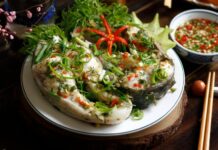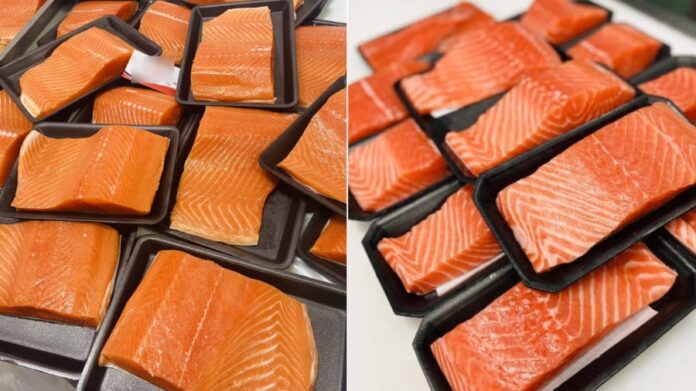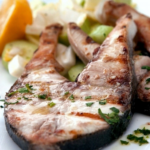Salmon is a popular and widely available fish that is loved by many. With this versatile ingredient, you can create a variety of delicious dishes such as sashimi, sushi, pan-seared salmon, grilled salmon, or even salmon paste.
Selecting Fresh Salmon
You can purchase salmon from supermarkets, seafood markets, or online retailers. When buying salmon, it’s important to look out for certain characteristics to ensure you’re getting the best quality. Here are some tips for choosing fresh salmon, shared by professional chefs.
Salmon sold in supermarkets is typically pre-cut into portions. The belly, tail, and head portions are usually separated.
If you plan to use the salmon for sashimi, grilling, pan-searing, or making paste, opt for the belly or rib portions. The tail and head portions have less meat and tend to dry out when cooked with heat. These parts are usually reserved for making soup.
For the rib or belly meat, pay attention to the color of the fat marbling and the flesh itself. The ideal salmon should have even white fat marbling and bright orange flesh. Avoid trays of salmon that appear watery, as the meat tends to lose its elasticity.
To test for freshness, gently press your finger on the salmon. If the indentation bounces back, it’s fresh.
Often, salmon is sold with the skin removed, making it difficult to observe the fat marbling near the skin. If you come across salmon with the skin still intact, examine the fat closest to the skin. It should be a bright white color, indicating a delicious piece of salmon. Avoid salmon with dark-colored fat near the skin.

Choose salmon with white fat marbling, bright-colored flesh, and good elasticity.
Freezing and Thawing Salmon
If you intend to cook the salmon within a day, you can store it in the refrigerator at a temperature below 5°C. For longer storage, it’s best to freeze the salmon.
When freezing salmon, blot dry the surface of the fish and wrap it tightly in plastic wrap. Place the wrapped salmon in a box and close the lid securely. Put the box in the freezer.
To thaw the salmon, transfer it from the freezer to the refrigerator. You can also thaw it slowly by placing it in the refrigerator the night before you plan to use it. Do not thaw salmon at room temperature, as this can cause the fish to release water, affecting the elasticity and integrity of the fat marbling and flesh. This results in a mushy texture and compromises the taste.
The Sweet Meat Fish: A Bone-less, Omega-3 Rich Alternative to Salmon, at a Fraction of the Cost.
Omega-3 fatty acids are essential for maintaining and optimizing your body’s functions. With a plethora of benefits, Omega-3s enhance your vision, strengthen your brain’s performance, and improve memory. Found abundantly in fish, these fatty acids are a must for a healthy body and mind. In Vietnam, a local fish offers an affordable and accessible source of Omega-3, akin to salmon, readily available in local markets.
The Cooler Side of Sa Pa: 7 Local Delicacies to Try
Sa Pa is a renowned summer getaway, offering a respite from the heat. This picturesque hill station boasts a plethora of delectable specialties that visitors must indulge in. From savory treats to sweet delights, Sa Pa’s culinary scene is a gastronomic journey waiting to be explored. Embark on a flavor-filled adventure and discover the unique tastes that have made this destination famous.
The Ultimate Superfood: Unlocking the Power of this Omega-3 Rich Fish
When it comes to omega-3-rich foods, salmon often springs to mind. However, it’s not the only fish in the sea with exceptional omega-3 content. In fact, according to leading health experts, the crown for the highest omega-3 levels goes to mackerel. This silvery swimmer is a true powerhouse when it comes to providing your body with those all-important healthy fats. So, if you’re looking to boost your omega-3 intake, consider adding mackerel to your menu and giving your health a real fin-tastic treat!





































